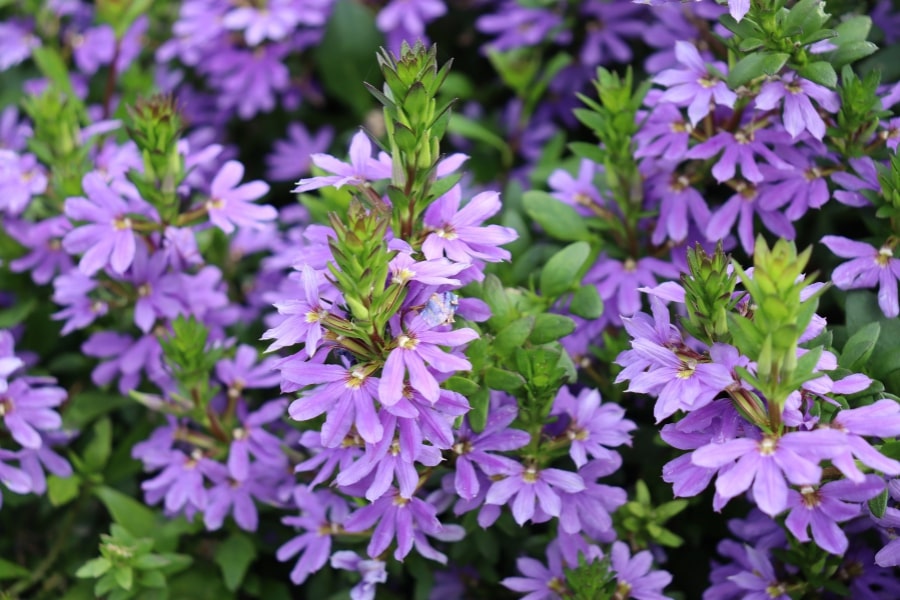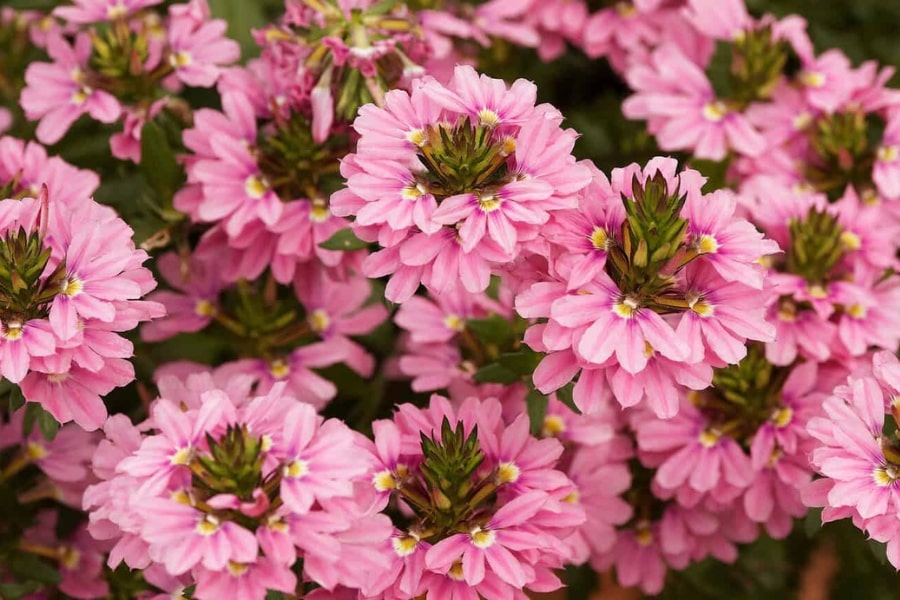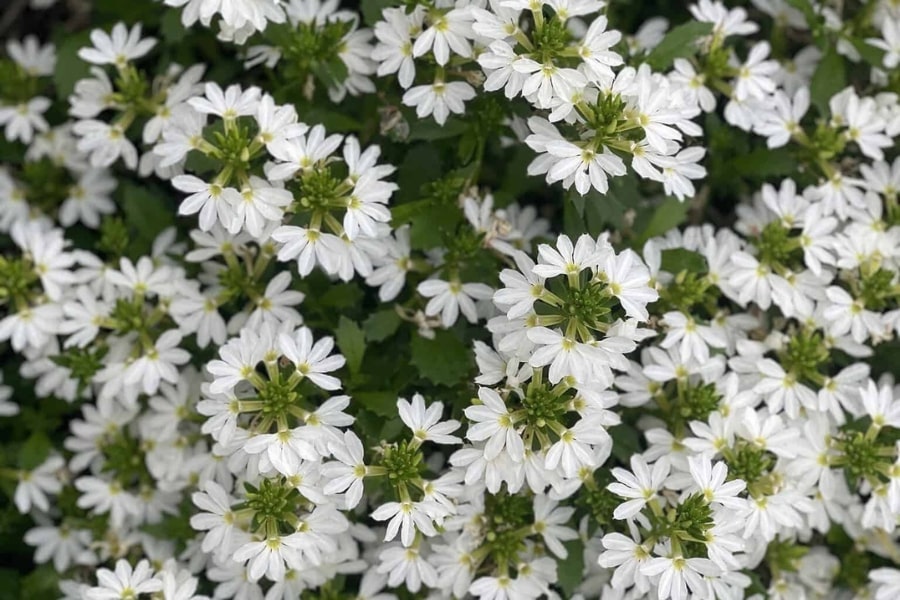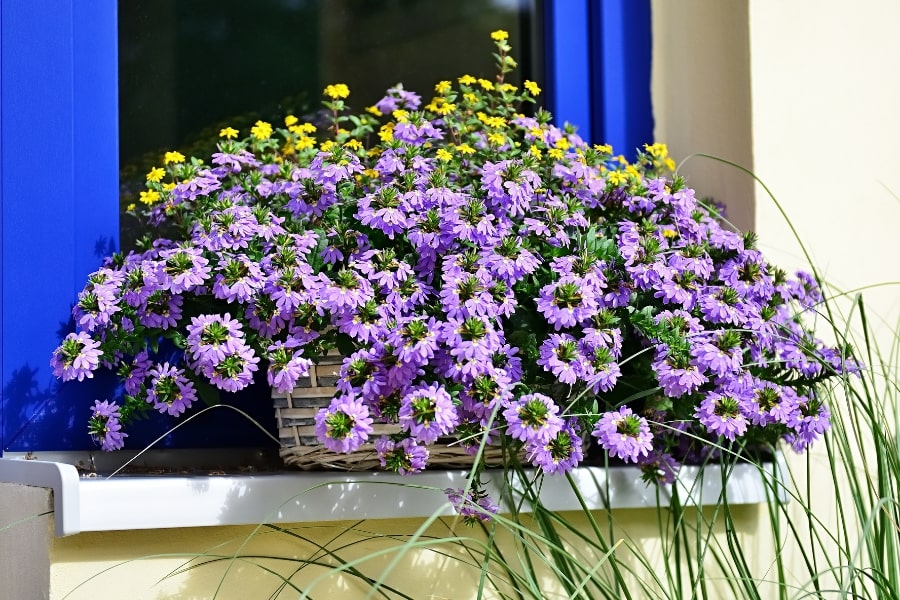Commonly known as Fan Flower, Scaevola is a charming annual native to the coastal regions of Australia and New Zealand, where it thrives in sunny, well-drained conditions. This plant is easily recognized by its distinctive fan-shaped blossoms, which appear to be only half a flower—a unique trait that gives the plant its name. Throughout the summer months, Scaevola bursts into bloom with an abundance of delicate flowers in shades of blue, lavender, pink, purple, and white, creating a beautiful cascading effect in containers, window boxes, and hanging baskets.

Our Selection of Scaevola
We grow 4″ containers and hanging baskets featuring every color in the Surdiva and Bombay series. While we rely on our vendors for the Scampi, Scalora, and Whirlwind series, we strive to keep a full spectrum available—though the pink variety can sometimes be in short supply.
We are growing the following varieties in 2025:
- Bombay Dark Blue
- Bombay White Improved
- Fairy Pink
- Lavender Blessing
- Scalora Suntastic
- Stardiva Blue
- Surdiva Blue Violet
- Surdiva Fashion Pink
- Surdiva Purple
- Surdiva White
Scaevola arrives in early April and is usually sold out by mid-May. However, we can sometimes source 4″ and 10″ hanging baskets from our vendors for later in the growing season.
Growing and Caring For Scaevola
When planting Scaevola, choose a location with full sun to partial shade. While it can tolerate some shade, it blooms best in bright sunlight. The soil should be well-draining and enriched with organic matter. Once established, Scaevola is drought-tolerant. If you crash this plant and then add water, the plant will return to its original state without yellowing or losing flower buds. If you’re growing Scaevola in containers, use a high-quality potting mix designed for flowering plants to ensure adequate drainage.
Caring for Scaevola is relatively straightforward. Deadheading faded flowers is not necessary. The plant is relatively self-cleaning. Scaevola maintains continuous blooms all season and maintains a neat appearance. It is also generally resistant to pests and diseases, though it’s a good idea to inspect the plant occasionally for any signs of trouble. Adding a slow-release fertilizer during the growing season will provide essential nutrients for healthy growth and abundant blooms.
Fan Flower likes to be watered regularly but will tolerate drying out and becoming crispy. Just add water and it will return to a regular blooming plant without all the yellowing that other plants experience when dry. This makes Scaevola very hardy and drought resistant.

Leaves and Flowers
The leaves of Scaevola are typically succulent, elongated, and paddle-shaped, creating a lush and tropical appearance. Their glossy, dark green color serves as a perfect backdrop for the plant’s stunning blooms. Scaevola flowers are the true highlight, with fan-shaped petals that resemble small, delicate seashells. These blooms come in various colors, including shades of blue, lavender, pink, and white, adding a vibrant burst of hues to the surroundings.

Uses in the Garden
Due to its low-growing, spreading habit, it is commonly used as a border plant or in rock gardens. Fan Flower is also an excellent choice for containers and can be grown in hanging baskets or window boxes for a cascading effect. Additionally, the plant attracts pollinators such as butterflies and bees, making it a great addition to any garden.

Frequently Asked Questions
Is Scaevola Deer Resistant?
Scaevola is considered deer-resistant. Deer tend to avoid plants with strong scents, tough or fuzzy leaves, or poisonous ones. Scaevola typically has smooth, leathery leaves and produces small, fan-shaped flowers that are not known to be particularly attractive to deer. While no plant can be considered completely deer-proof, scaevola is generally less appealing to deer than other garden plants. However, if deer pressure is high in your area, they may still nibble on Scaevola if other food sources are scarce.
Is Scaevola Toxic To Dogs?
Scaevola, commonly known as fanflower, is not listed as toxic to dogs. Scaevola is generally considered safe for dogs to be around and is unlikely to cause toxicity if ingested in small quantities.
Is Scaevola Annual Or Perennial?
Scaevola is typically grown as an annual in most regions, including the SC Upstate. However, it is a perennial plant in its native habitat, Australia, and other warm climates. In areas with mild winters, such as USDA hardiness zones 9-11, Scaevola may behave as a perennial, returning year after year.
